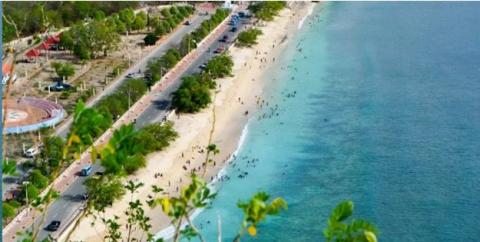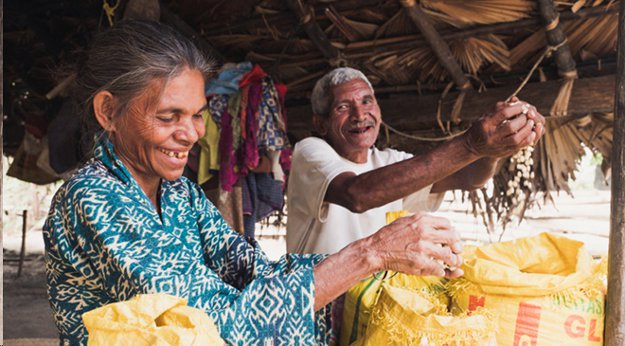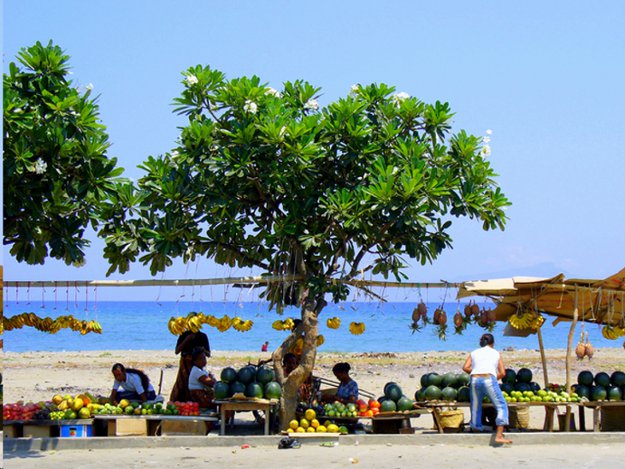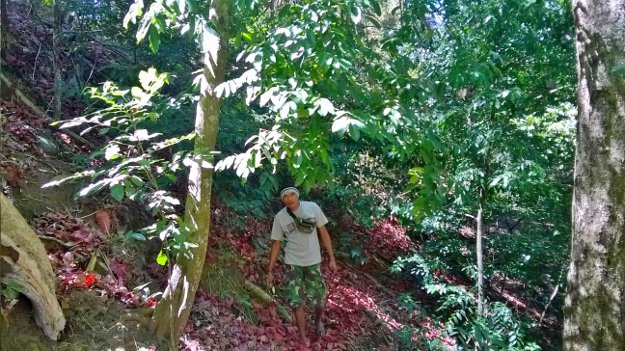Trekking in East Timor: The Road Less Travelled

Two hours into the hike along the cobbled path towards Mount Tatamailau, Timor-Leste’s highest peak, we started to question whether we were going the right way.
It had been a long day already. The plan had come together in a late-night burst of inspiration, and a chance conversation with the owner of my hostel in Dili, the capital city of Timor-Leste. The guidebooks made it sound difficult to get to the mountain, where Kym, the owner of Dili Central Backpackers, made it sound like a breeze. I didn’t much want to go on my own, but she soon conjured up a fellow traveller who was more than up for an adventure, and the seed of the idea thus flowered.
The path we took up to the mountain village was objectively beautiful, overhung with tropical foliage giving way to misty hills. The air was fresh, and largely untainted by the exhaust smoke that trails over much of the Asian continent. Here, you could count on one hand the number of vehicles that had been past us. That handful was just enough to convince us to keep going; to convince us that they had to be heading towards civilisation, and that we weren’t going to be left bedding down on the mountainside for the night.
It was a tenuous reassurance, but one that was sorely needed.

Travelling in Timor-Leste is the epitome of taking the road less travelled. Indeed, these particular roads less travelled often barely qualify as such. In my diary I described the difference between West Timor and East, after crossing the land border, thus: ‘One has roads. The other has stretches of beaten-down track, which are used by vehicles to travel from point to point… There were more potholes there than actual road.’
The Indonesian portion of the journey allowed for peaceful slumber, inasmuch as it was possible in a cramped minibus; the other ensured a rude awakening. It was amazing how both sides could be a part of the same island, two halves of Timor, yet manifested as worlds apart.
East Timor became independent in 2002, making it Asia’s youngest country, and one of the youngest in the world. The UN peacekeeping forces only left in early 2013, which is just one chapter of the rough ride it has had throughout its history. Timor-Leste has lived through colonizing influences from the Portuguese, Dutch and Spanish, endured Japanese occupation during World War II, and subsequently a horrific Indonesian invasion and occupation, during the course of which tens of thousands of protesting Timorese were killed. The country has suffered through a lot in order to reach the relative stability it enjoys today.
It’s not surprising then that tourism is a relatively young industry. And nowhere was this more evident than in the journey from the capital to the rugged peak of Mount Tatamailau. While in neighbouring Indonesia there would be myriad tour groups offering tailored services for tourists, in Timor-Leste there is a minibus, a public truck, a necessary reliance on hitchhiking, depending on the day of the week, and a dearth of readily available information. It’s brilliant, if challenging.
In order to get to the jumping-off point for the mountain, a town called Maubisse, you have to grab a microlet, a kind of overstuffed minibus, to the central market in Dili, navigating a convoluted route not delineated by timetable or map. From there, you hop on an open-top truck, and wait for it to fill with people and animals and cargo: wizened ladies with leathery skin and cheeks full of chewing tobacco, chickens clucking quietly in cloth-covered baskets, and 25 kilo bags of rice. After increasing incredulity at the Timorese definition of ‘full’, which in the UK would translate to a health and safety hazard, you trundle for several hours up steep streets, wending your way round potholes and piles of rubble.
Timor-Leste is a country under construction. The road up to Maubisse was patchwork: stretches of glorious tarmac interspersed with much longer stretches of road populated with construction vehicles and their operators, filling in fissures and creating drainage systems. A work in progress, like much of the nation.
The directions we were going off were shaky, to say the least: amalgamated from the collected advice of old blogs and people whose friends had been there recently. Second- or third-hand instructions; recycled wisdom. But that was the easy part.
It’s four hours, we had been told, to get from Maubisse up to the mountain village of Hatobuilico, from where the mountain trek begins. But from Maubisse we’d already expended a lot of time walking along a dusty, construction-riddled main road, then hitching a lift in the back of a pickup truck. All that was before even reaching the start of the path which, as mentioned, we had been walking up for two hours.

The suggested four hours, or equivalent, had already elapsed. Had we picked the wrong route?
It began to rain, a light drizzle that would have been refreshing in less uncertain circumstances, but for now simply mixed with the sweat forming across our foreheads and served to catalyze our frustration. The road was largely deserted, save for the occasional motorbike that came up the track, shuddering its way over the cobblestones. Helmeted faces turned to stare, baffled, as they revved their way past: tourists, two of them; young white girls, in a country where foreigners are few and far between. Tourists walking, not in the safety of a 4x4 as they wend their cushioned way up to the mountain.
In Timor-Leste, it feels as though they haven’t quite worked out what to do with tourists yet. There is none of the hassle that you find in other Southeast Asian countries, and none of the crowds. East Timor’s 70,000 annual visitors pales in comparison to nearby Indonesia’s 11 million. The tourist attractions in East Timor are concentrated in pockets: there is one foreign-run eco-retreat on Atauro Island off the coast of Dili, and one small touristy market in the centre of the capital, touting clothing adorned with the Timorese flag and colourful hand-woven textiles. People do not bother you, though they might stare in confusion. The most common congregations of foreigners in the country are still aid workers, not camera-toting tourist groups. While every volcano or mountain peak in Indonesia is crammed with selfie sticks, we had the mountain roads to ourselves.
We were a novelty, and we enjoyed it, grinning broadly at strangers as we marched onwards, and doing our best accents every time we uttered the one phrase we knew in Tetum, the predominant national language. There are around 40 distinct languages or dialects in Timor-Leste, though, so we didn’t even know whether we were being understood.

‘Boa tarde,’ we blithely said to each and every person we passed, having little to no idea what the replies we received in return meant. Good afternoon. It was always a good afternoon in Timor-Leste. Every afternoon was an adventure.
This adventure, though, was proving a little frustrating. We only continued along the path for lack of a viable alternative, trudging through the misty curtain of rain until weak rays of sun began to filter through. It was not long, though, before the light faded and the optimism of day transitioned to the obscurity of dusk, then dark.
We did eventually made it to the village of Hatobuilico, after at least two further hours of rounding every corner expecting that the distant house on the horizon signified our imminent arrival. Four hours, it turned out, was how long it took to hike just from the main road up to the village, not from the town of Maubisse, and in fact it had taken us a bit longer.
When we arrived it was late, and dark, and we had just one frail torch beam between us. We found the first available guesthouse, hurriedly made arrangements for a guide to see us up the mountain the following morning, shovelled some dinner into our mouths, and collapsed into surprisingly comfortable beds.

The sunrise hike, in the end, was by far the easiest part of the journey. Just a 3am wake-up, three hours of trudging up steep slopes, biting winds at the summit only marginally alleviated by the gloves and layers we had been advised to bring, and breath misted into being on the air.
The view from the peak was beautiful, of course, in the way that sunrises from a place on high always are: horizons spread out in many-layered splendour, ocean visible in both directions. The sun rose like fire flickering its way into life, edging the clearing clouds with a seam of golden light, and gradually warming our frozen fingers. We watched the day begin from 2963 metres, huddled next to a statue of the Virgin Mary, which provided yet another concrete reminder of the independence of Timor-Leste despite its proximity to Indonesia. Christianity is its majority religion, compared with Indonesia’s Islam.
It was easily one of the best sunrises I’ve ever seen. Certainly though, the experience was made all the better by the sheer effort it had cost us to get there. And that was the story of the experience of visiting East Timor in its entirety.
It’s not easy, it isn’t straightforward, nor is it laid out in simplicity on a map or in a guidebook, but as with many things, the challenge of the journey made it infinitely more worth it in the end.
East Timor was by far one of my favourite spots in Southeast Asia. It’s an underdog, with none of the popularity and publicity of places like Bali, Phuket and Hanoi. But everyone roots for an underdog, and in my limited experience of the place, it exceeded expectations in every way.
Author Bio:
Ellie Hattersley is a contributing writer at Highbrow Magazine.
For Highbrow Magazine
Photo credits: yeowatzup (Wikimedia, Creative Commons); Emus Usboko (Wkimedia, Creative Commons); yeowatzup (Wikimedia, Creative Commons).






























































































































































































































































































































